This article has been reviewed according to Science X's editorial process and policies. Editors have highlighted the following attributes while ensuring the content's credibility:
fact-checked
peer-reviewed publication
trusted source
proofread
JWST sees four exoplanets in a single system
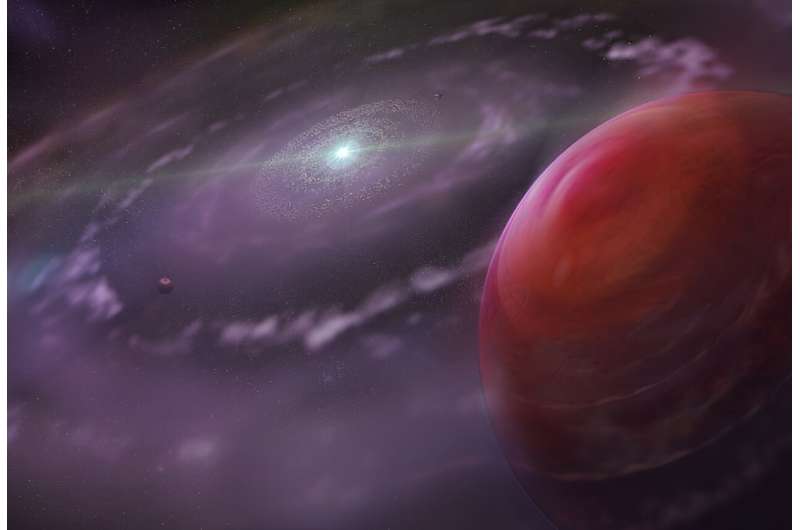
When the JWST activated its penetrating infrared eyes in July 2022, it faced a massive wish-list of targets compiled by an eager international astronomy community. Distant, early galaxies, nascent planets forming in dusty disks, and the end of the universe's dark ages and its first light were on the list. But exoplanets were also on the list, and there were thousands of them beckoning to be studied.
But one distant solar system stood out: HR 8799, a system about 133 light-years away.
Why this system over others? 15 years ago astronomers discovered three exoplanets orbiting the star. Not long after they announced a fourth, all detected with direct imaging. They're all massive planets on wide orbits, which are rare. The HR 8799 system is also young, another important point.
The fact that they were discovered 15 years ago is also important; it means we have observations of these planets that span a lengthy time. This type of data is critical to understanding other solar systems because the duration of the data paints a more complete picture.
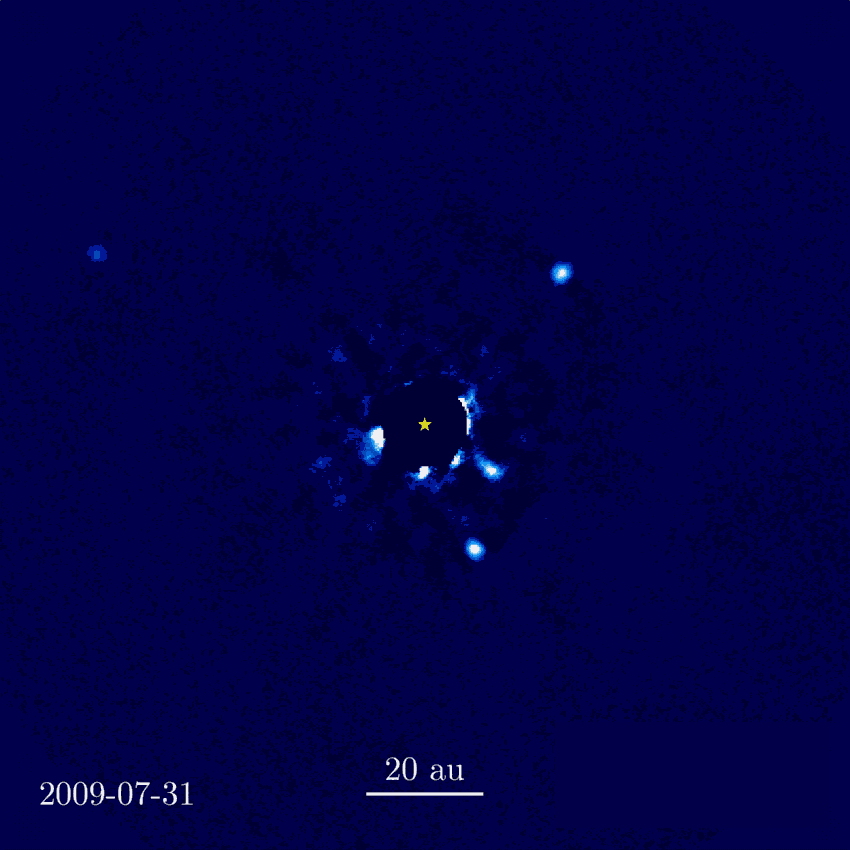
However, it also poses more questions and whets our appetite for more answers.
That's why the JWST observed the system recently. Its MIRI instrument and its coronagraph can perform the kind of high-contrast imaging needed to understand the system better.
A new paper presents the results of these observations. It's title is "Imaging detection of the inner dust belt and the four exoplanets in the HR 8799 system with JWST's MIRI coronagraph." It'll appear in the journal Astronomy and Astrophysics and is currently posted to the arXiv preprint server. The lead author is Anthony Boccaletti from the LESIA, Observatoire de Paris, France.
HR 8799 is 1.5 times more massive than the sun and is almost five times more luminous. It's also surrounded by a debris disk and is only about 30 million years old. Young solar systems are important because they can reveal the intricate details behind planet formation, one of the things the JWST was built to focus on.
The four planets are HR 8799 b, c, d, and e. They're all massive planets, between 5.7 and 9.1 Jupiter masses, barely below the point where deuterium fusion takes place, making them brown dwarfs. They range from 16 to 71 astronomical units away from the star, and have orbits from about 45 to about 460 years. All four of them have radii of about 1.2 Jupiter radii.
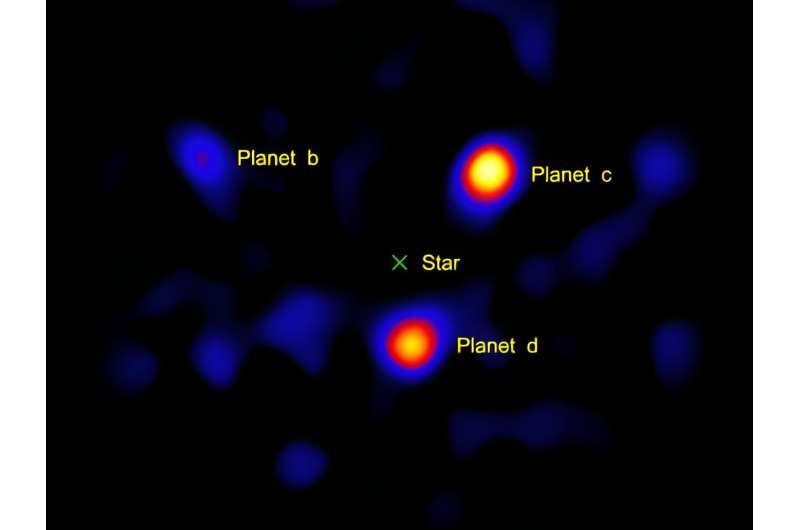
Massive giant planets that follow large orbits greater than 5 AU are rare. So every instance of these types of planets is important. MIRI's high contrast imaging can open up a new window on these types of systems and allowing scientists to characterize them more fully. Mid-infrared observations of the system have been difficult up until now. Not only that, but the JWST's angular resolution makes the observations even more powerful.
What did the JWST find?
"Overall, the MIRI images of the HR 8799 system yield a very different vision than in the near IR, with the clear detection of the four planets, together with a localized but extended central emission," the authors write.
The JWST was able to refine what we already know about some aspects of this system. The main objective of this work was to characterize the planetary atmospheres better.
While there has been some uncertainty around the nature of the planets, and if they are brown dwarfs, the JWST observations put that idea to rest. "Their colors indicate that these four giant planets differ from field brown dwarfs," the authors write.
Their temperatures range from 900 K to 1300 K, with HR 8799 b being fainter and cooler. The JWST measurement's shows that planet b's temperature is lower than previous observations showed, an indication of the telescope's greater power. MIRI also identified two atmospheric chemicals unequivocally: H2O and CO. The authors say there's a debatable detection of methane, and that's additional evidence that they're planets not brown dwarfs. Brown dwarfs always show the signature for methane at these temperatures.
The JWST's MIRI instrument was built with different filters. They were partly designed to investigate the presence of ammonia, which is a solid biosignature on terrestrial planets. Unfortunately, these four planets are a little too hot for ammonia to stand out. "As a result, the current data cannot conclude on the detectability of the ammonia feature in the HR 8799 planets," the paper states. If it had detected ammonia, it would be headline news.
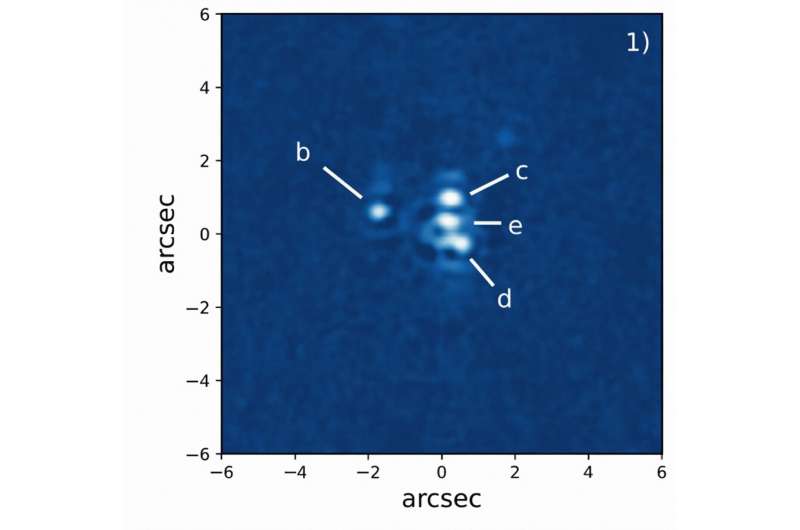
The HR 8799 system is also noteworthy for its debris disk. It's unusual in that it has two belts. Researchers have wondered if the inner edge of the outer belt was caused by a fifth planet with a mass between Jupiter's and Saturn's. Others thought it might be a dust clump.
But the JWST shows that it's a background object, and seems to have ended the debate. "With a new data point, 4.44 years apart from the former detection, we can now safely conclude that this is a background object," the authors write.
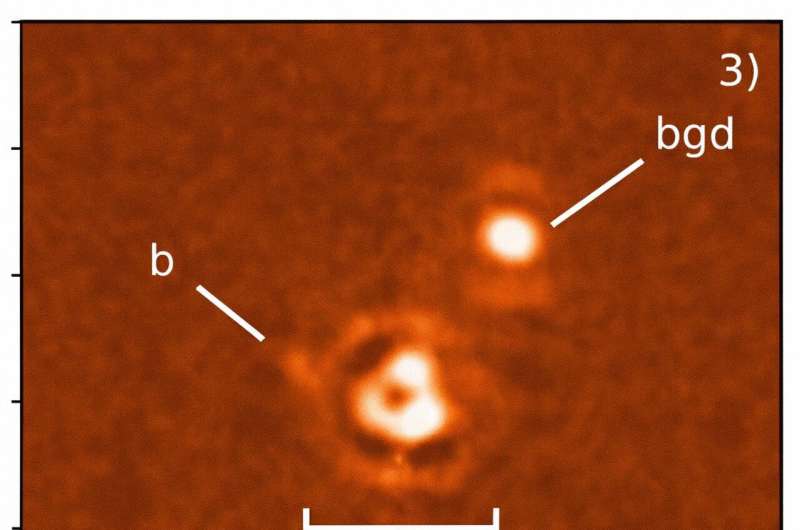
This was the JWST's first look at a young exoplanetary system with its MIRI instrument, including its filters and its coronagraph. "The MIRI instrument onboard JWST is now offering high-contrast imaging capacity at mid-IR wavelengths, thereby opening a completely new field of investigation to characterize young exoplanetary systems," the authors explain.
As such, the main thrust of the work was to test the observations and different algorithms to determine how to best use it in future work, and how to interpret the results. For example, measuring a planet's flux successfully means accounting for how the coronagraph attenuates the images, depending on a planet's position.
These observations contribute to using the instrument more effectively. Ironically, MIRI's coronagraph can be so sensitive that understanding its images of young stellar systems can be challenging. The use of the instrument is only in its infancy, and the coronagraphs extreme sensitivity "can make the detection and the interpretation of young system observations very challenging, not mentioning the confusion related to background galaxies," the authors write.
The authors point out that there's still room for improvement, and these results will only lead to improved future results.
More information: Boccaletti A. et al, Imaging detection of the inner dust belt and the four exoplanets in the HR8799 system with JWST's MIRI coronagraph, arXiv (2023). DOI: 10.48550/arxiv.2310.13414
Journal information: arXiv , Astronomy & Astrophysics
Provided by Universe Today





















